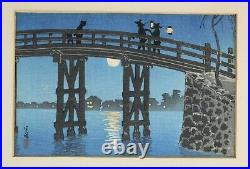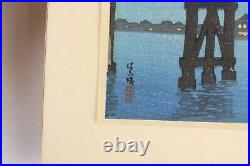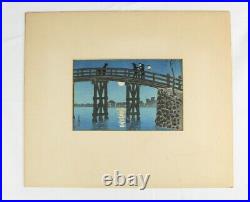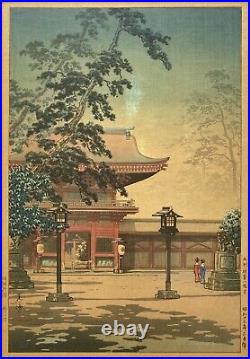
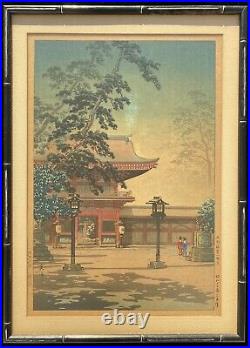
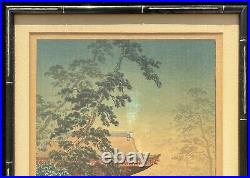
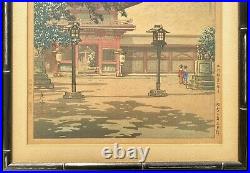
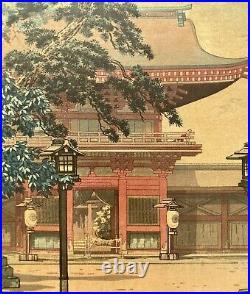
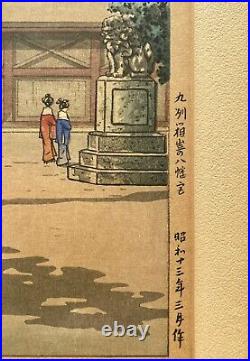

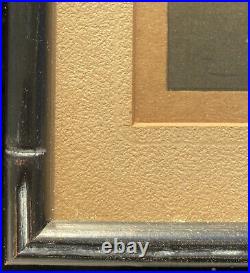
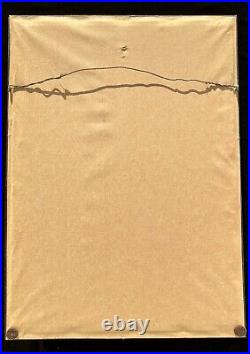
An original antique woodblock print titled “Hakozaki Hachimangu Temple, Kyushu” by Japanese artist, Tsuchiya Koitsu. Likely printed between 1938 and 1945 according to the “Triple Offset” publisher’s seal in the lower left margin (DOI Publishers). The print depicts a classic cultural Japanese image, with two geishas walking in the courtyard in front of the Hakozaki Hachimangu Temple/Shrine. Signed at lower left corner, Koitsu, with artist’s seal Ko, the title along the margin followed by the date, Showa jusannen san gatsu saku (made in Showa 13 [1938], 3rd month)? With publisher’s seal on lower left margin, hanken shoju Doi Hangaten, followed by printer’s seal Yokoi and carver’s seal Harada. This design is an early Doi publication, as evidenced by the Harada/Yokoi carver/printer seals (Yokoi was only active as a printer through 1945). Framed in a black painted bamboo frame under light protective UV glass, overall dimensions approximately 19” x 13.75”. Size inside the mat is approximately 16” x 10.75”. Print in fair condition. Yellowing due to age. Not inspected out of frame. Some wear to frame. Please review all images. Born near Hamamatsu with the name “Koichi”, Koitsu moved to Tokyo at age of fifteen. He planned to apprentice with a woodblock carver named Matsuzaki who worked for the artist Kobayashi Kiyochika. Instead, he became Kiyochika’s student and moved into his home to study art and print design. Koitsu lived there for 19 years, working and studying with Kiyochika. Much of his skill at depicting light can be attributed to his studies with Kiyochika. During 1894-95, Koitsu designed several war prints for the Sino-Japanese war efforts. He later worked as a lithographer. In 1931, Koitsu met the publisher Watanabe at an exhibition commemorating the work of Kiyochika. The following year he designed the first of many prints for Watanabe, titled Cherry Blossom Viewing at Gion. He went on to design ten prints for Watanabe. Koitsu also designed numerous prints for the publisher Doi Teiichi, as well as several other publishers including Kawaguchi & Sakai, Baba Nobuhiko, and Takemura. Tsuchiya Koitsu designed shin hanga landscape prints during the same time as the landscape artist Ishiwata Koitsu, but the two men were not related. Their works are sometimes confused since artisans signed both works “Koitsu”. However, the styles of their woodblock prints are distinctive. This item is in the category “Antiques\Asian Antiques\Japan\Prints”. The seller is “princetonarts” and is located in this country: US. This item can be shipped to United States, Canada, United Kingdom, Denmark, Romania, Slovakia, Bulgaria, Czech Republic, Finland, Hungary, Latvia, Lithuania, Malta, Estonia, Australia, Greece, Portugal, Cyprus, Slovenia, Japan, China, Sweden, Korea, South, Indonesia, Taiwan, South Africa, Thailand, Belgium, France, Hong Kong, Ireland, Netherlands, Poland, Spain, Italy, Germany, Austria, Bahamas, Israel, Mexico, New Zealand, Philippines, Singapore, Switzerland, Norway, Saudi Arabia, United Arab Emirates, Qatar, Kuwait, Bahrain, Croatia, Republic of, Malaysia, Brazil, Chile, Colombia, Costa Rica, Panama, Trinidad and Tobago, Guatemala, Honduras, Jamaica, Antigua and Barbuda, Aruba, Belize, Dominica, Grenada, Saint Kitts-Nevis, Saint Lucia, Montserrat, Turks and Caicos Islands, Barbados, Bangladesh, Bermuda, Brunei Darussalam, Bolivia, Ecuador, Egypt, French Guiana, Guernsey, Gibraltar, Guadeloupe, Iceland, Jersey, Jordan, Cambodia, Cayman Islands, Liechtenstein, Sri Lanka, Luxembourg, Monaco, Macau, Martinique, Maldives, Nicaragua, Oman, Peru, Pakistan, Paraguay, Reunion, Vietnam, Uruguay.
- Featured Refinements: Japanese Woodblock Print
- Region of Origin: Japan
- Age: 1938-1945
- Primary Material: Paper
- Maker: Tsuchiya Koitsu
- Original/Reproduction: Antique Original
- Color: Multi-Color
